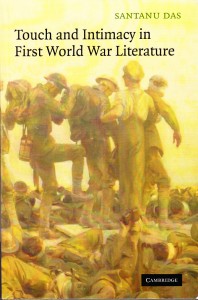First World War writing is an old interest of mine so when I came upon a book with the intriguing title
‘Touch and Intimacy in the First World War I picked it up at once.
The writer had an Indian-sounding name, Santanu Das, but I had never heard of him before.
The book’s first chapter is called ‘Slimescapes’ and it is about the ways in which First World War writers dealt with the tactile experience of trench warfare. ‘In everyday trench life, the boundaries of the body can no longer be policed, as bodily fluids are perpetually on the brink of spillage. In Blasting and Bombardiering, the officer breaks wind at the sound of shelling; men vomit as they collect corpses in Graves’s Goodbye to All That and Cloete’s A Victorian Son. Winterbourne defecates in his trousers in Death of a Hero, as does the young boy in Remarque’s All Quiet on the Western Front. Just as bodily fluids leak out, similarly mud and slime seep in: Céline speaks of ‘eating Flanders mud, my whole mouth full of it, fuller than full’; in ‘A Night of Horror’, the narrator writes: ‘The suffocating mud and slime/ Were trickling down my throat’. Remarque, towards the end of his novel, observes: ‘Our hands are earth, our bodies mud and our eyes puddles of rain.’ Membrances have become permeable: the skin can no longer separate the inside and outside, the self and the world.’ (p. 52)
I read the book at a stretch, finishing it in a couple of sittings (I don’t think this has ever happened to me before with a book of literary criticism). But one thing puzzled me: if the writer was Indian, as his name suggested, why had he made no reference to the one million Indians who were on the Western front during the First World War? Was this deliberate and if so why?
I went to the Net and googled Santanu Das. I learnt that he was on the faculty of Queen Mary college in London, and that ‘Touch and Intimacy’ had been awarded Britain’s prestigious Leverhulme Prize, which carries a cash reward of 70,000 Pounds Sterling!
I discovered also that Santanu had already addressed some of my queries: he had recently edited a book called Race, Empire and First World War Writing (CUP, 2011) for which he had written a long introduction as well as an essay called: Indians at Home, Mesopotamia and France 1914-1918; towards an intimate history.
I had the impression that Santanu had studied in Kolkata at some point so I wrote to a friend, Sukanta Chaudhuri, who, together with his wife Supriya Chaudhuri, has inspired a generation of literature students at Kolkata’s Jadavpur University. Sure enough it turned out that he had taught Santanu briefly. He introduced me to Santanu over the Net.
I don’t often write fan letters, but I relished writing this one.
Dear Santanu (if I may)
I read ‘Touch and Intimacy’ a few months ago and have wanted to tell you since then that it is the best work of literary criticism I’ve read in years. As I said to Sukanta, it is is really very rare nowadays to come across critics who actually seem to like the bodies of work they’re writing about – and since it is perhaps even more rare to come across one who actually writes comprehensible prose, it could be said that you are in danger of becoming the Snow Leopard of Literary Criticism! (I should add here that I am sure Sukanta and Supriya played an important part in steering you away from the prevalent fashions… it’s wonderful to see that some aspects of Calcutta’s intellectual legacy have survived against all the odds).
In any event your empathy for the First World War writers was very moving to me because I’ve been interested in that body of work since my college days ( I feel I have an almost familial connection with Robert Graves et al because my wife wrote a biography of Laura Riding and spent a long time in Mallorca, talking with Beryl Graves). I was glad also to see that your book has been very well received – this recognition is richly deserved. Congratulations!
Santanu wrote back to say that a friend had given him a copy of The Shadow Lines when he was leaving for Cambridge and that he had done his undergraduate thesis on the book. So our correspondence got off to a good start.
It so happened that I was due to travel to London soon afterwards. I arranged to meet Santanu
and we had a long talk, over dinner.
I was glad to learn that Santanu’s new project is a book that explores, at greater length, some of the themes and materials he addressed in his essay: Indians at Home, Mesopotamia and France 1914-1918; towards an intimate history (I will be writing about this article at greater length soon).
Since then Santanu has sent me a few paragraphs about his current project and a few photographs as well. I plan to post them later this week.



Reading your comments about Robert Graves and your wife’s book about Laura Riding I suddenly realized that I once met both you and her in person! It was when you were taking a tour of a school for one of (or all of?) your children. I was the school librarian and we spoke briefly. I didn’t know who you were then or that one day your books Sea of Poppies and River of Smoke would completely consume my imaginative life for some months. (Months, not days because I limited my reading rapture to the subway commute.) But I was interested at that time in Robert Graves and his circle, so when your wife mentioned her book about Laura Riding I took notice. I did read her book when it was published and was impressed by her sympathy for Laura (at the time partly shocked as well–I was much younger then and saw the world in black and white).
It is a pleasure to read this blog and I can’t wait to try out all the books you recommend.